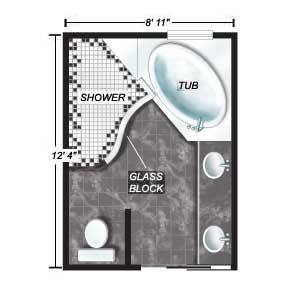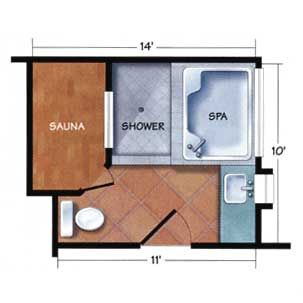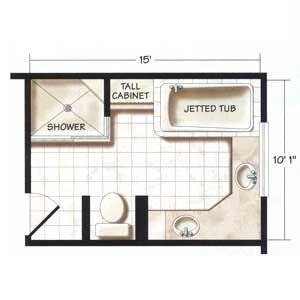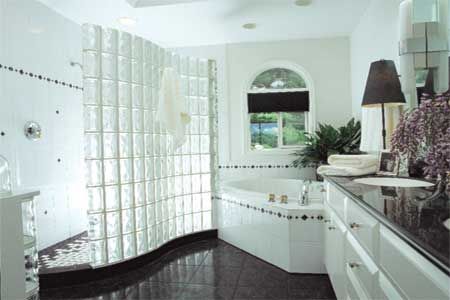Showers are perfect for speed-cleaning on workday mornings. But by the end of the week, it’s great to be able to unwind in the tub with a soothing soak. If you’re thinking about remodeling or adding on that primary bath you’ve always wanted, you might want to consider substituting a separate tub and shower for the more typical combination model. Separating your shower and tub can offer more design flexibility and options for customization. In this guide, we’ll explore the benefits of separate shower and tub areas and provide expert advice on how to make this upgrade work in your space.
The Benefits of Separate Shower and Tub Areas

Separating your shower and tub has numerous advantages for both daily use and your overall home value. A stand-alone shower is convenient, while a separate tub allows for relaxing soaks, catering to different preferences for different members of the household.
Additionally, separate fixtures often provide more design options and can make a bathroom feel more spacious. They allow for customization of each area, such as adding luxury features like rainfall showerheads or jetted tubs. From a practical standpoint, having distinct spaces can make cleaning easier and potentially extend the lifespan of each fixture.
Many homeowners also appreciate the aesthetic value that separate tubs and showers can add to their bathrooms. It creates a spa-like ambiance that amplifies the sense of relaxation, and modern designs can also be easily incorporated, offering a personalized touch to your bathroom decor.
Assessing Your Bathroom Space for a Separate Tub and Shower
Before beginning a bathroom renovation, evaluate your available space. While separate tubs and showers can work in various bathroom sizes, careful planning is needed to ensure a functional and comfortable layout.
Typical Dimensions for Tubs and Showers
Understanding standard fixture sizes is the first step in determining if your bathroom can accommodate separate units. Here are some common dimensions to consider:
- Standard tubs: 60 inches long by 30 inches wide
- Newer comfort tubs: 72 inches long
- Standalone showers: Available in 36 x 36, 36 x 42, and 36 x 48-inch models
- Corner units: Can be space-saving options for both tubs and showers
Creative Ways To Maximize Bathroom Square Footage
If your initial assessment comes up short, there are several strategies to gain additional space, such as:
- Repurpose adjacent closet space
- Extend into an unused hallway area
- Install a corner tub or shower to optimize floor space
- Explore space-saving fixtures like sliding shower doors or compact tubs
Considering Accessibility and Universal Design
As you plan your bathroom layout, consider who will be using the space. Universal design concepts can ensure your bathroom is comfortable and accessible for everyone. Features such as grab bars, nonslip flooring, and barrier-free showers enhance safety and convenience. Think ahead to possible future needs to avoid more renovations down the line.
Designing Your Ideal Bathroom Layout With an Independent Shower and Tub
Creating an efficient and appealing bathroom layout requires carefully considering both practical needs and design preferences. A well-planned layout can make even a modestly sized bathroom feel spacious and luxurious.
Considering Clearance and Accessibility
When designing your bathroom, keep these important clearances in mind:
- Allow 30 inches for a standard swinging shower door
- Ensure 15 inches of clearance from the centerline of the toilet to any adjacent wall or cabinet
- If you’re making a bathroom accessible, be sure to follow ADA guidelines for bathrooms
These specifications are typically outlined in local building codes. Consult your local building department for specific requirements in your area.

Optimizing Fixture Placement for Functionality
Arrange your fixtures logically to enhance the flow and functionality of your bathroom. Consider placing frequently used fixtures like the sink and toilet closer to the door, while positioning the tub and shower in more private areas. If your bathroom has a view, you may want to orient the tub or shower to take advantage of it.
Integrating Efficient Storage Options
Ample storage space is essential in any well-designed bathroom. Incorporate a mix of open and closed storage to keep necessities within reach while maintaining a clutter-free look. Built-in shelves, recessed niches, and vanity cabinets offer excellent storage solutions without compromising on style. Make sure your design includes enough storage for toiletries, towels, and other essentials to keep your bathroom organized and functional.

Plumbing Considerations for Separate Tub and Shower
Understanding the basics of plumbing can help you make informed decisions about your bathroom renovation and potentially save on costs.
Supply Pipes and Drain-Waste-Vent Systems
Plumbing systems consist of two main components: Supply pipes, which deliver hot and cold water to fixtures, and a drain-waste-vent (DWV) system, which removes wastewater and prevents sewer gases from entering the home.
When separating your tub and shower, you’ll need to account for both systems. This may involve extending existing pipes or installing new ones, depending on your layout.
Cost-Saving Strategies in Plumbing Reconfiguration
To minimize plumbing costs, consider the following strategies:
- Place the tub and shower on the same wall to share plumbing lines.
- Avoid moving the toilet if possible, as relocating the waste line can be expensive.
- Use a half-wall to conceal plumbing while creating visual separation.
- Consult a plumbing contractor early in the planning process to identify potential issues and cost-saving opportunities.
Preparing for Future Maintenance
While planning your new bathroom layout and plumbing, consider future maintenance needs. Ensure that access panels and plumbing shutoff valves are easy to reach. This can save you time and money if repairs are needed.
Choosing the Right Tub and Shower for Your Space
Selecting the perfect fixtures ensures you’re creating a bathroom that meets your needs and reflects your style.
Selecting the Perfect Tub
When choosing a tub, consider factors such as:
- Size: Ensure it fits comfortably in your space and accommodates everyone who will use it.
- Style: Consider available options for types of bathtubs, including freestanding, drop-in, and alcove tubs.
- Material: Choose from acrylic, cast iron, or composite materials based on durability and weight considerations.
- Features: Determine if you want jets, built-in armrests, or other luxury elements.
Finding the Ideal Shower Enclosure
For showers, keep the following factors in mind:
- Size: Determine how much space you can dedicate to the shower area.
- Door type: Options include sliding, pivot, or frameless doors.
- Enclosure material: Glass, acrylic, stone, and tile are popular choices. You can mix and match different materials to create visual interest.
- Showerhead and controls: Consider rainfall showerheads, handheld showerhead options, or multiple spray heads for a spa-like experience.
Exploring Whirlpool Tubs as a Separate Fixture
Whirlpool tubs can add a more luxurious feel to your tub. Here are some of the benefits:
- Multiple jets (typically four to 12) for targeted massage
- Adjustable water flow and pulse rates
- Ergonomic designs with lumbar support and neck rests
- Inline heating elements to maintain water temperature
Installation Challenges and Solutions
However, installing a whirlpool tub presents unique challenges, including the following:
- Weight: These tubs may require additional floor support.
- Access panel: Ensure easy access for maintenance. This may limit your options for positioning the tub.
- Noise reduction: Consider using plaster of Paris or rubber motor mounts to minimize vibrations.
- Hot water supply: You may need to upgrade your water heater to accommodate the larger water volume.
Balancing Bathroom Aesthetics and Practicality
Creating a beautiful and functional bathroom means considering both form and function. If possible, position your tub or shower to take advantage of natural light and outdoor views. Consider using frosted glass or strategically placed windows to maintain privacy while allowing light to enter.
Choose materials that not only look great but can also withstand the humid bathroom environment, such as these:
- Flooring: Nonslip tiles, luxury vinyl, or natural stone
- Wall coverings: Moisture-resistant paint, tiles, or waterproof wallpaper
- Fixtures: High-quality, corrosion-resistant metals like brushed nickel or chrome
- Countertops: Quartz, granite, or solid surface materials for durability and easy maintenance
Small, thoughtful details can also make a big difference in your bathroom’s overall look. Coordinating hardware finishes, adding stylish bathroom lighting, and incorporating decorative elements like mirrors and artwork can tie the entire design together.
Budget Considerations for Separate Tub and Shower Projects
Separating your tub and shower can vary widely in cost depending on the scope of work and chosen fixtures.
To make the most of your budget, spend extra on high-quality plumbing fixtures and faucets for longevity and invest in proper waterproofing to prevent costly water damage. When looking for ways to save, try choosing standard-sized fixtures to avoid custom work, and consider refinishing existing elements like tubs or tile if they’re in good condition.
Always plan for contingencies and unexpected expenses. Allocate a portion of your budget—typically about 10% to 15%—for unforeseen issues that may arise during the renovation.

